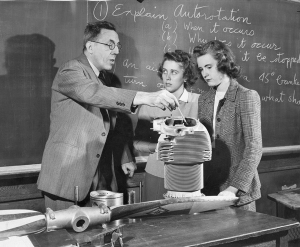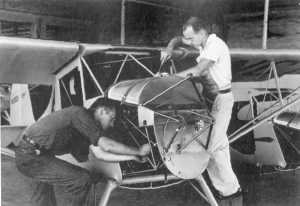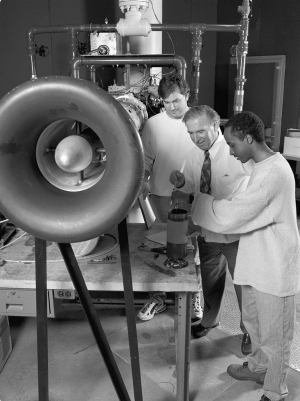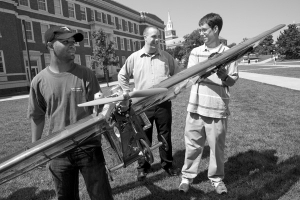Still Climbing
University of Cincinnati's Aerospace Systems School stays its course toward advancing flight
Launched in 1929 by a former barnstormer and visionary inventor, the University of Cincinnati aerospace engineering program traces its 82-year flight path alongside some of the most important developments and enduring personalities in the history of air travel.
Having crossed trajectories with such names as Orville Wright, Charles Lindbergh, Werner von Braun and Neil Armstrong, the faculty and grads of the country's second oldest aeronautical engineering program have made an untold number of strides toward advancing the industry -- from the days of prop-driven planes to jet airliners to rocket-propelled spaceships.
The program started the same year as the Great Depression under the guidance of Bradley Jones, a daring navigator who was best known for his record flight from Dayton to Boston in 1923, the first nonstop jaunt to rely solely on instrumentation for navigation (which he also developed). The former World War I major gained further fame when Charles Lindbergh insisted on having Jones' Earth inductor compass aboard the Spirit of St. Louis to navigate his epic solo transatlantic flight from New York to Paris.
Birth of co-op
Recognized for both his characteristic energy as well as his expertise, Jones was selected to develop the country's first co-operative education program in aeronautical engineering at Cincinnati, a fitting choice considering Dean Herman Schneider birthed the idea for co-op at UC in 1906. The five-year curriculum combined rigorous academic requirements interspersed with cooperative work experience.
Of historical note, Jones turned to Orville Wright, just 50 miles up the road, as a consultant to help shape the program's curriculum. Despite the depression years of the 1930s, UC was able to place co-op students from the program with employers in the rapidly evolving industry.
As WWII approached, the College of Engineering began to incorporate military training in the program, and once war broke out, the college provided a 12-week training period for women undergraduates to become "Goodyear Girls" or airplane factory supervisors. Not surprisingly, much of the aeronautics research at UC also shifted to war-related efforts such as testing propeller blades in UC's old wind tunnel.
Space race begins
After the war, UC experienced a sustained enrollment spike as a result of the GI Bill. The following decade saw geopolitical influences became a key driver of the pace of aerospace education, particularly after the Soviets launched Sputnik -- the first human-made object to orbit the Earth -- in 1957.
With that historic moment, the space race -- and to a great extent the arms race -- began in earnest. While the United States had proclaimed itself the world leader in space technology, the Soviets were the first to conquer outer space. For days, Americans watched as the USSR's satellite traversed their night skies. President Dwight Eisenhower referred to it as the "Sputnik crisis," and the government reacted by pouring billions more dollars into engineering, math and science.
Soon the name "aeronautical engineering" gave way to "aerospace engineering" at UC, and the demand for an advanced-degree program intensified as did UC's relationship with such partners as the Aeronautical Research Laboratory at Wright-Patterson Air Force Base.
Tabakoff propels program
Fortunately for the future of UC's aerospace program, and particularly its graduate program, a Bulgarian PhD named Widen Tabakoff dropped by the department while in Cincinnati on assignment from Werner von Braun, the world-famous rocket scientist who developed the Saturn V rocket that propelled Apollo to the moon.
Tabakoff was in Cincinnati to work with the U.S. Army Engineering Division Laboratory to test materials for use in the nozzle of the Saturn V when he became acquainted with UC's faculty. Offered a position at UC, Tabakoff accepted, and so began a relationship with UC that would last more than a half-century.
By 1959, Tabakoff and UC colleagues from mathematics, physics and astronomy (including Paul Herget, Eugene Rabe and Peter Musen) formed the Institute of Space Sciences at UC, the conduit for UC's graduate program, of which Tabakoff became director. The advanced-degree offerings at UC immediately garnered attention from nearby General Electric Aircraft Engines (GEAE) in Evendale.
By 1966, Tabakoff had developed a special degree program specifically for employees of GE. Over the years, the co-op program for students who attend classes at UC and GE-Evendale has led to more than 1,000 graduate degrees for employees of the world's leading provider of commercial and military jet engines.
Tabakoff won millions in federal funding as head of UC's Center of Excellence in Propulsion, which started in 1968. His lab represented a major step forward as UC was able to not only attract externally funded research but also support a long line of graduate students who would help take UC's study of rocket propulsion, combustion, aerodynamics and other areas to a whole new level. Among them was an Egyptian-born woman named Awatef Hamed, who would later became department head in 2001.
Neil Armstrong joins faculty
Just before Hamed started teaching at UC in 1972, five new professors joined the aerospace program, including UC's most famous faculty member, Neil Armstrong, who taught at UC from 1971 until 1979. Hamed recalls students being fascinated to learn from such a celebrity, but for fellow professors, it was business as usual sharing a break room with the first man to set foot on the moon.
"We just went to lunch and so on and so forth," she says. "We didn't bug him and treat him like a star. He went to his office and did his work like the rest of us."
In 1980, the department name changed again to reflect an emphasis on solid mechanics and dynamics. It was known as the Aerospace Engineering and Engineering Mechanics program until 2000. Along the way, the program boosted research funding, particularly from NASA, and won its first award for an Ohio Eminent Scholar in 1994. A rare second Ohio Eminent Scholar was added just last year.
10 Aerospace Grads Who Took Flight Ray Bisplinghoff, Eng ’40, MS (Eng) ’42, HonDoc ’63, led advances in research and technology for NASA and was intimately involved in planning Apollo missions 8, 9, 10, 11 and 12. He later served as engineering dean at MIT and deputy director of the National Science Foundation. He was also elected to both the National Academy of Sciences and the Royal Aeronautical Society. Rodney Boudreaux, Eng ’60, PhD (Eng) ’65, became vice president at RocketDyne, a chief supplier of NASA’s rocket engines, particularly the Saturn family that powered the Apollo moon program. Jim Thomas, Eng ’61, enjoyed a 26-year career as an Air Force test pilot who flew more than 40 different kinds of planes, including the F-15, U2 and F-117A Stealth Fighter. Retired as a colonel in 1987. Larry Lantzer, Eng ’61, a decorated Navy test pilot who became air department head on the U.S.S. Constellation and squadron commanding officer at Pearl Harbor. Barry Hannah, Eng ’63, MS (Eng) ’65, PhD (Eng) ’73, became the Navy’s preeminent aerospace engineering leader for strategic nuclear reentry systems. Kenneth Token, Eng ’63, became McDonnell Douglas’ director of engineering of “Phantom Works,” the corporation’s classified projects area. John Morrison, Eng ’66, retired as vice president after three decades with Gulfstream. Thomas Wakeman, Eng ’71, PhD (Eng) ’82, was instrumental in developing the revolutionary unducted fan engine, led nozzle design for the F-16 fighter, holds 39 patents and led the effort to design UC’s hot erosion tunnel to measure erosion characteristics. Richard Johnson, Eng ’73, became chief engineer and vice president for Gulfstream and was instrumental in design and certification of the Gulfstream III, IV and V executive jet program. Dinesh Keskar, MS (Eng) ’77, PhD (Eng) ’79, became president of Boeing India and vice president of Boeing International Trading. |
Building on its rich history, UC's Aerospace Systems School continues to research and develop leading-edge technologies in both air and space travel. And if Cincinnati leaders have their way, UC will continue to make scientific advancements that would make even a founding visionary like Bradley Jones proud.
Much of the information in this article is taken from research by Art Davies and the publication "Aerospace Engineering at the University of Cincinnati Co-operative Education and Research," by A. Morrison, A. Hamed, W. Tabakoff and G. Slater – 2004.
Related article:
Aerospace director builds on 43 years

 Past Issues
Past Issues


